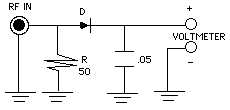
RF WATTMETER
Cost estimate: $1
This useful project is so simple I didn't waste film on it! With a few components, a voltmeter and a little math you can measure the approximate output of your QRP transmitter.
Resistor R is the load (a dummy load: 50 ohms). RF voltage is sampled across the load and rectified; DC voltage appears at the meter terminals. Make sure the total power rating of R can handle your transmitter's anticipated output. For the "Michigan Mighty Mite" use two 1/2-watt 100-ohm resistors in parallel, which yields a 1-watt power rating: plenty enough for that transmitter. A ceramic disc type capacitor is fine; use a germanium (1N34A) diode.
To determine approximate peak power output in watts:
Power = (ExE)/R
where
E = Meter reading in volts
and
R = Load Resistance in ohms (50 ohms)
When powered by 14 volts my version of the Mighty Mite makes the meter read 4.5 volts, so
Power= (4.5 x 4.5) / 50
= 20.25 / 50
= 0.405 W
...is the approximate peak power output.
I wouldn't bet on the absolute accuracy of this, but it does give
an in-the-ballpark indication of what's being transmitted.
(Thanks to Bruce Barley KB0PZD for his technical advice revising this page!)
..need parts?...
Source:
Sessions, Kendall Webster (ed.),
Master Handbook of 100 Practical Electronic Circuits, Solid State Edition,
(Blue Ridge Summit, PA: TAB Books Inc, 1988) p 315.
***HOME***
***RECEIVER***
***Q-MULTIPLIER***
***2-BAND VFO***
***500mW TRANSMITTER***
***3W 2-BAND TRANSMITTER***
***15 METER CONVERTER***
***15 METER VXO-TUNED TRANSMITTER***
***FIELD STRENGTH METER***
***CRYSTAL TESTER***
***SUPPLIERS***
comments?
email: jandg@brink.com
